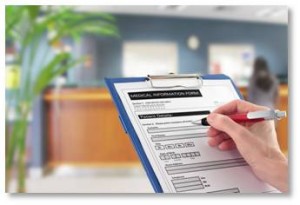Guest Author: Seth Kaplan
Remember the last time you navigated the bureaucratic shoals of your health insurance provider? Remember the patient paperwork you had to slog through? Today some of it’s done by phone but the process is no less annoying.
 Are you having trouble sleeping? Me, too. The bruises on my ribs document my wife’s opinion of my snoring. To add insult to that injury, she told me one morning that I stopped breathing a lot during the night. ‘You’ve got apnea’,” she pronounced.
Are you having trouble sleeping? Me, too. The bruises on my ribs document my wife’s opinion of my snoring. To add insult to that injury, she told me one morning that I stopped breathing a lot during the night. ‘You’ve got apnea’,” she pronounced.
Armed with that subjective but heart-felt diagnosis, I went to see my internist. Looking at my pear-shaped less-than-perfect body, and factoring in my complaints of brain fog and extreme fatigue, he agreed to refer me for an at-home sleep study. This involves getting:
- 30 minutes of training on an at-home sleep device,
- Using the device at home for another 30 minutes, and
- Returning the device to the medical facility the next day.
Sounds simple, no?
The Field Call
Yes, but it is not. First, I had to field a call from the referral team, a group of folks whose job it is to gather and verify information they extract from patients. Then they send the information to Medicare so that they can approve the procedure. The conversations always begin the same way:
“Mr. Kaplan?”
“Yes.”
“Has any of your information changed?”
“No.”
“Your birthdate, month, day, and year?”
“January 2, 1947.”
“And, you’re still at 123 Smith Street?”
“Yes.”
“In Anytown, MA, is that right?”
“Yes.”
“The zip code?”
“01212.”
“Phone number 123-456-7890?”
 “That’s the land line. Use my cell phone.”
“That’s the land line. Use my cell phone.”
“I have listed a secondary number, 978-397-9958. Is that correct.”
“Yes.”
“And, you have Medicare?”
“Yes.”
“And do you have Medex?”
“Yes.”
“Please give me the first three digits of the Medex number.”
It turns out they are letters, but I provide them.
“And all this information is current?”
“Yes.” [Steam is now coming out of my ears.]
At this point, I thought I was done, but noooo. Providing all this information meant that they could complete the paperwork and send it to Medicare to determine whether that organization would approve my getting the sleep study.
Two weeks pass. Two weeks!
The Call
My cell phone rings. Luckily, my car is Bluetooth-equipped, so I can answer hands free without losing my view of the road or concentration.
“May I speak to Seth Kaplan?”
“This is he.”
“Mr. Kaplan?”
“Yes.”
“My name is Bernice. I am calling from the Sleep Study Department at the hospital. I need to check you in by verifying some information. This will take just a few minutes.”
Swallowing my disbelief at this time estimate, I reply, “Okay. Go ahead.”
“Has any information changed?”
“No, everything is the same.” Maybe I can get this over with quickly. Maybe . . . Nooooo!
“Okay, this’ll just take a minute. We’ll get through it together.”
 [What you mean, “We,” bureaucracy girl?]
[What you mean, “We,” bureaucracy girl?]
She proceeds to review with me all the same information, in the same order, that the previous bureaucracy girl had done. (Do they have a guild or union?). Then, she surprised me by having a few arrows in her question quiver that I hadn’t expected. At least, not from her, because I had read them each year on my Federal tax form!
“Does this have anything to do with black lung disease?”
“No.”
“Are you, or have you ever been, an employee of a railroad?”
“No.” Okay, enough is enough. “Do you see that this is one of the big reasons health insurance costs go up?”
“We’ll be done in just a minute. We will get through this together.”
“I repeat my question: Do you see that this is one of the big reasons health insurance costs go up.”
Now comes her killer response: “Hey, I get paid to do this. IT’S GREAT!”
And, now I am well and truly pre-registered. At least for this procedure. Next time — who knows?
